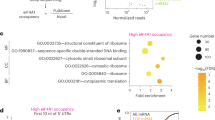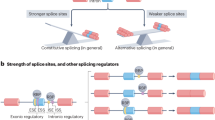Abstract
Protein inhibitor of activated STAT (Pias) and human homologues of seven in absentia (hSiah) proteins both exhibit properties of ubiquitin-family peptides conjugating enzymes. Pias present E3-ligase activity for small ubiquitin-related modifiers (Sumo) covalent attachment to their targets. This post-translational modification is responsible for the activation of different transcription factors such as AP1. HSiah proteins possess ubiquitin-E3-ligase activity that triggers their partners to proteasomal-dependent degradation. The present study identifies Pias as a new hSiah2-interacting protein. We demonstrate that hSiah2 regulates specifically the proteasome-dependent degradation of Pias proteins. On reverse, Pias does not prevent hSiah2 degradation. We provide evidences for hSiah2-dependent degradation of Pias as being a mechanism in the regulation of c-jun N-terminal kinase-activating pathways. This report describes a new interconnection between sumoylation and ubiquitination pathways by regulating the levels of the E3-ligases available for these processes.
This is a preview of subscription content, access via your institution
Access options
Subscribe to this journal
Receive 50 print issues and online access
$259.00 per year
only $5.18 per issue
Buy this article
- Purchase on Springer Link
- Instant access to full article PDF
Prices may be subject to local taxes which are calculated during checkout






Similar content being viewed by others
Abbreviations
- aa:
-
amino acid
- Ab:
-
antibody
- CHX:
-
cycloheximide
- E3:
-
E3-ubiquitin-protein ligase
- hSiah:
-
human homologues of seven in absentia
- Pias:
-
proteins inhibitor of activated STAT
- SUMO:
-
small ubiquitin-related modifiers
- Ub:
-
ubiquitin
References
Chung CD, Liao J, Liu B, Rao X, Jay P, Berta P et al. (1997). Specific inhibition of Stat3 signal transduction by PIAS3. Science 278: 1803–1805.
Della NG, Senior PV, Bowtell DD . (1993). Isolation and characterisation of murine homologues of the Drosophila seven in absentia gene (sina). Development 117: 1333–1343.
Depaux A, Regnier-Ricard F, Germani A, Varin-Blank N . (2006). Dimerization of hSiah proteins regulates their stability. Biochem Biophys Res Commun 348: 857–863.
Desterro JM, Rodriguez MS, Kemp GD, Hay RT . (1999). Identification of the enzyme required for activation of the small ubiquitin-like protein SUMO-1. J Biol Chem 274: 10618–10624.
Desterro JM, Thomson J, Hay RT . (1997). Ubch9 conjugates SUMO but not ubiquitin. FEBS Lett 417: 297–300.
Driscoll J, Goldberg AL . (1990). The proteasome (multicatalytic protease) is a component of the 1500-kDa proteolytic complex which degrades ubiquitin-conjugated proteins. J Biol Chem 265: 4789–4792.
Duval D, Duval G, Kedinger C, Poch O, Boeuf H . (2003). The ‘PINIT’ motif, of a newly identified conserved domain of the PIAS protein family, is essential for nuclear retention of PIAS3L. FEBS Lett 554: 111–118.
Floyd ZE, Trausch-Azar JS, Reinstein E, Ciechanover A, Schwartz AL . (2001). The nuclear ubiquitin-proteasome system degrades MyoD. J Biol Chem 276: 22468–22475.
Fogal V, Gostissa M, Sandy P, Zacchi P, Sternsdorf T, Jensen K et al. (2000). Regulation of p53 activity in nuclear bodies by a specific PML isoform. EMBO J 19: 6185–6195.
Freemont PS . (2000). RING for destruction? Curr Biol 10: R84–R87.
Germani A, Bruzzoni-Giovanelli H, Fellous A, Gisselbrecht S, Varin-Blank N, Calvo F . (2000). SIAH-1 interacts with alpha-tubulin and degrades the kinesin Kid by the proteasome pathway during mitosis. Oncogene 19: 5997–6006.
Germani A, Prabel A, Mourah S, Podgorniak MP, Di Carlo A, Ehrlich R et al. (2003). SIAH-1 interacts with CtIP and promotes its degradation by the proteasome pathway. Oncogene 22: 8845–8851.
Germani A, Romero F, Houlard M, Camonis J, Gisselbrecht S, Fischer S et al. (1999). hSiah2 is a new Vav binding protein which inhibits Vav-mediated signaling pathways. Mol Cell Biol 19: 3798–3807.
Gross M, Liu B, Tan JA, French FS, Carey M, Shuai K . (2001). Distinct effects of PIAS proteins on androgen-mediated gene activation in prostate cancer cells. Oncogene 20: 3880–3887.
Habelhah H, Frew IJ, Laine A, Janes PW, Relaix F, Sassoon D et al. (2002). Stress-induced decrease in TRAF2 stability is mediated by Siah2. EMBO J 21: 5756–5765.
House CM, Frew IJ, Huang HL, Wiche G, Traficante N, Nice E et al. (2003). A binding motif for Siah ubiquitin ligase. Proc Natl Acad Sci USA 100: 3101–3106.
Hu G, Chung YL, Glover T, Valentine V, Look AT, Fearon ER . (1997a). Characterization of human homologs of the Drosophila seven in absentia (sina) gene. Genomics 46: 103–111.
Hu G, Zhang S, Vidal M, Baer JL, Xu T, Fearon ER . (1997b). Mammalian homologs of seven in absentia regulate DCC via the ubiquitin-proteasome pathway. Genes Dev 11: 2701–2714.
Johnson ES, Gupta AA . (2001). An E3-like factor that promotes SUMO conjugation to the yeast septins. Cell 106: 735–744.
Kahyo T, Nishida T, Yasuda H . (2001). Involvement of PIAS1 in the sumoylation of tumor suppressor p53. Mol Cell 8: 713–718.
Kotaja N, Vihinen M, Palvimo JJ, Janne OA . (2002). Androgen receptor-interacting protein 3 and other PIAS proteins cooperate with glucocorticoid receptor-interacting protein 1 in steroid receptor-dependent signaling. J Biol Chem 277: 17781–17788.
Lallemand-Breitenbach V, Zhu J, Puvion F, Koken M, Honore N, Doubeikovsky A et al. (2001). Role of promyelocytic leukemia (PML) sumolation in nuclear body formation, 11S proteasome recruitment, and As2O3-induced PML or PML/retinoic acid receptor alpha degradation. J Exp Med 193: 1361–1371.
Liu B, Gross M, ten Hoeve J, Shuai K . (2001a). A transcriptional corepressor of Stat1 with an essential LXXLL signature motif. Proc Natl Acad Sci USA 98: 3203–3207.
Liu B, Liao J, Rao X, Kushner SA, Chung CD, Chang DD et al. (1998). Inhibition of Stat1-mediated gene activation by PIAS1. Proc Natl Acad Sci USA 95: 10626–10631.
Liu B, Shuai K . (2001). Induction of apoptosis by protein inhibitor of activated Stat1 through c-Jun NH2-terminal kinase activation. J Biol Chem 276: 36624–36631.
Liu J, Stevens J, Rote CA, Yost HJ, Hu Y, Neufeld KL et al. (2001b). Siah-1 mediates a novel beta-catenin degradation pathway linking p53 to the adenomatous polyposis coli protein. Mol Cell 7: 927–936.
Liu YC . (2004). Ubiquitin ligases and the immune response. Annu Rev Immunol 22: 81–127.
Matsuzawa SI, Reed JC . (2001). Siah-1, SIP, and Ebi collaborate in a novel pathway for beta-catenin degradation linked to p53 responses. Mol Cell 7: 915–926.
Megidish T, Xu JH, Xu CW . (2002). Activation of p53 by protein inhibitor of activated Stat1 (PIAS1). J Biol Chem 277: 8255–8259.
Melchior F . (2000). SUMO- non classical ubiquitin. Annu Rev Cell Dev Biol 16: 591–626.
Millot GA, Feger F, Garcon L, Vainchenker W, Dumenil D, Svinarchuk F . (2002). MplK, a natural variant of the thrombopoietin receptor with a truncated cytoplasmic domain, binds thrombopoietin but does not interfere with thrombopoietin-mediated cell growth. Exp Hematol 30: 166–175.
Muller S, Berger M, Lehembre F, Seeler JS, Haupt Y, Dejean A . (2000). c-Jun and p53 activity is modulated by SUMO-1 modification. J Biol Chem 275: 13321–13329.
Muller S, Matunis MJ, Dejean A . (1998). Conjugation with the ubiquitin-related modifier SUMO-1 regulates the partitioning of PML within the nucleus. EMBO J 17: 61–70.
Nakayama K, Ronai Z . (2004). Siah: new players in the cellular response to hypoxia. Cell Cycle 3: 1345–1347.
Polekhina G, House CM, Traficante N, Mackay JP, Relaix F, Sassoon DA et al. (2002). Siah ubiquitin ligase is structurally related to TRAF and modulates TNF-alpha signaling. Nat Struct Biol 9: 68–75.
Reed JC, Ely KR . (2002). Degrading liaisons: Siah structure revealed. Nat Struct Biol 9: 8–10.
Rodriguez MS, Desterro JM, Lain S, Midgley CA, Lane DP, Hay RT . (1999). SUMO-1 modification activates the transcriptional response of p53. EMBO J 18: 6455–6461.
Sachdev S, Bruhn L, Sieber H, Pichler A, Melchior F, Grosschedl R . (2001). PIASy, a nuclear matrix-associated SUMO E3 ligase, represses LEF1 activity by sequestration into nuclear bodies. Genes Dev 15: 3088–3103.
Schmidt D, Muller S . (2002). Members of the PIAS family act as SUMO ligases for c-Jun and p53 and repress p53 activity. Proc Natl Acad Sci USA 99: 2872–2877.
Shuai K, Liu B . (2005). Regulation of gene-activation pathways by PIAS proteins in the immune system. Nat Rev Immunol 5: 593–605.
Simon MC . (2004). Siah proteins, HIF prolyl hydroxylases, and the physiological response to hypoxia. Cell 117: 851–853.
Sun L, Chen ZJ . (2004). The novel functions of ubiquitination in signaling. Curr Opin Cell Biol 16: 119–126.
Susini L, Passer BJ, Amzallag-Elbaz N, Juven-Gershon T, Prieur S, Privat N et al. (2001). Siah-1 binds and regulates the function of Numb. Proc Natl Acad Sci USA 98: 15067–15072.
Tan JA, Hall SH, Hamil KG, Grossman G, Petrusz P, French FS . (2002). Protein inhibitors of activated STAT resemble scaffold attachment factors and function as interacting nuclear receptor coregulators. J Biol Chem 277: 16993–17001.
Tang AH, Neufeld TP, Kwan E, Rubin GM . (1997). PHYL acts to down-regulate TTK88, a transcriptional repressor of neuronal cell fates, by a SINA-dependent mechanism. Cell 90: 459–467.
Tanikawa J, Ichikawa-Iwata E, Kanei-Ishii C, Nakai A, Matsuzawa SI, Reed JC et al. (2000). p53 suppresses the c-Myb-induced activation of heat shock transcription factor 3. J Biol Chem 275: 15578–15585.
Weissman AM . (2001). Themes and variations on ubiquitylation. Nat Rev Mol Cell Biol 2: 169–178.
Yaron A, Gonen H, Alkalay I, Hatzubai A, Jung S, Beyth S et al. (1997). Inhibition of NF-kappa-B cellular function via specific targeting of the I-kappa-B-ubiquitin ligase. EMBO J 16: 6486–6494.
Yeh WC, Shahinian A, Speiser D, Kraunus J, Billia F, Wakeham A et al. (1997). Early lethality, functional NF-kappaB activation, and increased sensitivity to TNF-induced cell death in TRAF2-deficient mice. Immunity 7: 715–725.
Zhang J, Guenther MG, Carthew RW, Lazar MA . (1998). Proteasomal regulation of nuclear receptor corepressor-mediated repression. Genes Dev 12: 1775–1780.
Acknowledgements
AD is the recipient of a fellowship from the Association pour la Recherche Contre le Cancer (ARC). This work is supported by grants from the ARC and La Ligue Nationale contre le Cancer (France). We acknowledge technical support provided in sequencing by F Letourneur's group (Cochin Institute).
Author information
Authors and Affiliations
Corresponding author
Rights and permissions
About this article
Cite this article
Depaux, A., Regnier-Ricard, F., Germani, A. et al. A crosstalk between hSiah2 and Pias E3-ligases modulates Pias-dependent activation. Oncogene 26, 6665–6676 (2007). https://doi.org/10.1038/sj.onc.1210486
Received:
Revised:
Accepted:
Published:
Issue Date:
DOI: https://doi.org/10.1038/sj.onc.1210486
Keywords
This article is cited by
-
PIAS4 is an activator of hypoxia signalling via VHL suppression during growth of pancreatic cancer cells
British Journal of Cancer (2013)
-
SUMO Rules: Regulatory Concepts and Their Implication in Neurologic Functions
NeuroMolecular Medicine (2013)
-
Starting and stopping SUMOylation
Chromosoma (2013)
-
The SUMO pathway: emerging mechanisms that shape specificity, conjugation and recognition
Nature Reviews Molecular Cell Biology (2010)
-
PIAS proteins: pleiotropic interactors associated with SUMO
Cellular and Molecular Life Sciences (2009)



